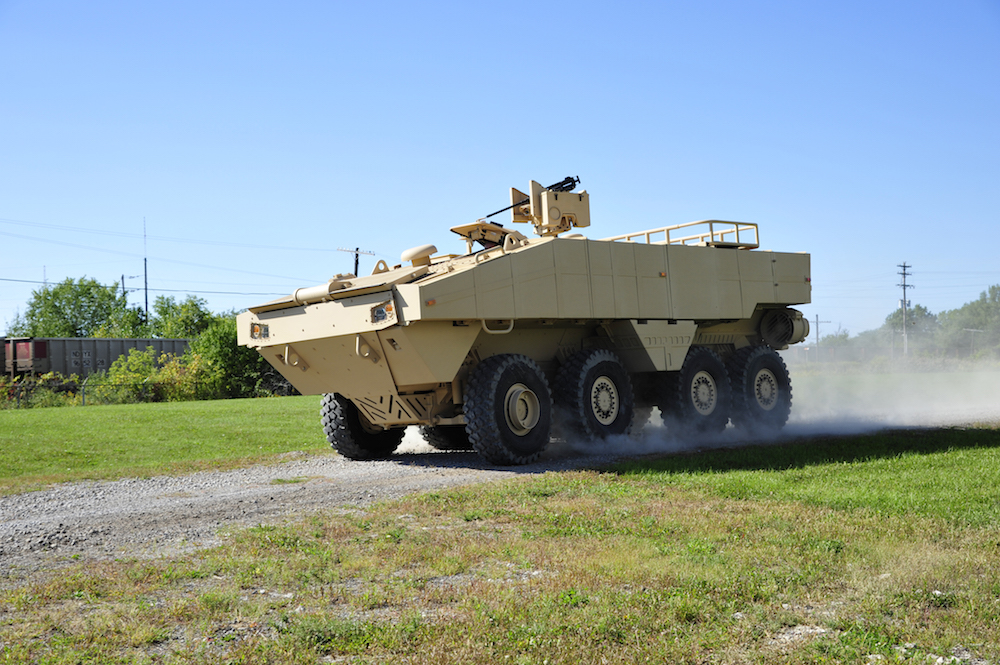It's Part Tank, Part Salamander, and Ready for Combat

A new amphibious vehicle that moves just as well on land as it does in the water looks kind of like a salamander. That is, if a salamander had eight wheels, a six-cylinder turbodiesel engine and weighed about 20 tons (18,100 kilograms).
Defense contractor Lockheed Martin designed and built the new Amphibious Combat Vehicle (ACV) to replace the U.S. Marine Corps' aging fleet of swimming tanks, which have been in use for more than four decades. The versatile new ACV was officially unveiled last week (Sept. 22) at the Modern Day Marine trade show in Quantico, Virginia.
Amphibious vehicles are very useful to Marines, who use the hybrid boat-tanks to travel safely between giant ships at sea and dry land. However, because they have to work in such varied environments, designing these machines can be a complicated (and expensive) process, according to David Hunn, technical director of Lockheed's ACV program. [7 Technologies That Transformed Warfare]
"For military amphibians, you don't have the benefit of swimming in calm lakes or canal ways and then driving on smooth roads," Hunn said in a statement. "You’re swimming through, oftentimes, big waves, ocean currents, nighttime and storms — and then operating in rough, off-road land conditions."
To build a vehicle that can handle all of these conditions, engineers first have to figure out one very important thing: how to get a 20-ton tank to float. To do this, Lockheed engineers have to ensure that the volume of water the ACV displaces weighs the same or more than the ACV itself. If the vehicle is less dense than the water, then it will float.
Once the vehicle can stay above water, engineers can tackle another issue — making the machine impermeable to both water and enemy attacks. To keep water out, the new ACV has limited openings where water can seep in, according to Hunn, who said that the vehicle features hatches up top and a large back door where troops can enter and exit the vehicle. There's also only one window up front for the driver, he said.
To help it withstand blasts from cannons and other artillery, Lockheed shaped the vehicle's hull (the body of the vehicle) to be "blast-resistant," but also "hydrodynamic," so it stays afloat.
Sign up for the Live Science daily newsletter now
Get the world’s most fascinating discoveries delivered straight to your inbox.
But perhaps the coolest thing about this modernized amphibious vehicle is the stuff you can't see — such as the computer system that converts the vehicle from a boat to a tank. Earlier amphibious vehicles had to be manually operated to switch modes when going from water to land, but the new ACV is automatic.
"We’re trying to make this where the driver doesn't have to make a lot of decisions under high pressure. When you hit the dashboard button that says 'swim,' everything changes automatically. The wheel works like a regular steering wheel, but it's now attached to the swim system," Hunn said.
In addition to a swimming propulsion system that thrusts the machine through the water at speeds reaching 5 knots, the ACV also has an extremely powerful engine that can keep it moving at upward of 60 miles per hour (96 km/h) on land. The vehicle's eight wheels facilitate its speediness, and allow it to move faster than if it used tracks (such as the ones on a bulldozer or tank) to get around.
While the primary purpose of Lockheed's ACV system is to build a new generation of vehicles for the military, the company also said it believes the salamanderlike machines would be great at search-and- rescue missions, as well.
"I think what we're going to see initially is commercial amphibian variants that are made for rescue operations — flooding situations that occur and you need to be able to get in to rescue people at a moment's notice," Hunn said.
Follow Elizabeth Palermo @techEpalermo. Follow Live Science @livescience, Facebook & Google+. Original article on Live Science.

Elizabeth is a former Live Science associate editor and current director of audience development at the Chamber of Commerce. She graduated with a bachelor of arts degree from George Washington University. Elizabeth has traveled throughout the Americas, studying political systems and indigenous cultures and teaching English to students of all ages.









